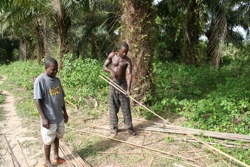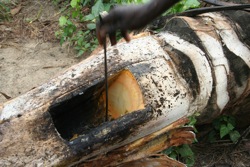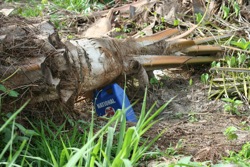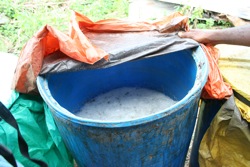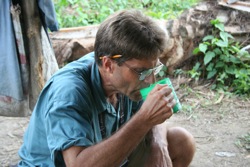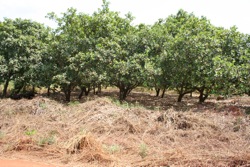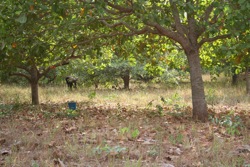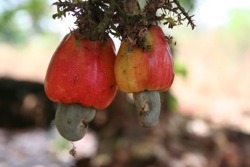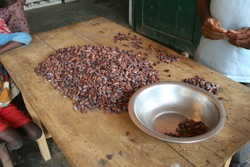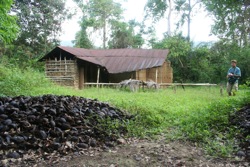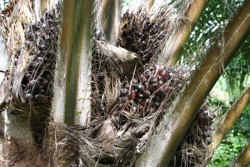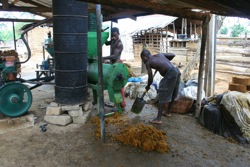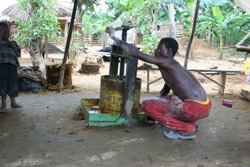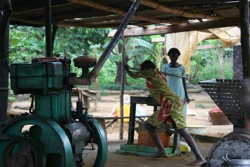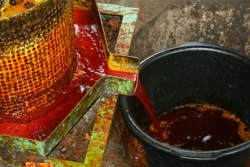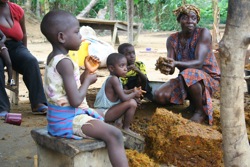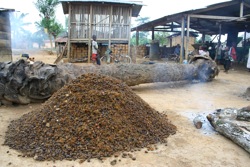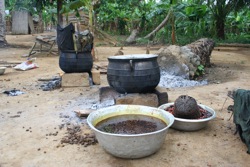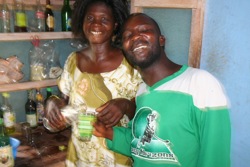Being a small encyclopedia of personal observations occasionally sprinkled with defensible facts
When I want to be "dead on balls accurate" as Mona Lisa Vito would say ("My Cousin Vinny") I rely almost exclusively on the utterly infallible resources of the interweb. Normally I thread these gems of wisdom unacknowledged into the prose. But as I researched background material for this page I came across so many examples of Ghanaian charm that I could not resist preserving some of the best intact. The quotes are always referenced to give credit where it is due, and are in italics.
African elephants
Back in the US I was watching a documentary on forest elephants, and some naturalists and their guide were trying to get close enough to one to sedate it and put a tracking collar on it. They were extremely cautious about being charged. This got me thinking: what's the difference between elephants, where Indian ones are regularly "domesticated," African elephants are not, but the particular individuals we encountered at Mole we could get reasonably close to, but the forest ones seem positively aggressive? The interweb reveals a couple of pertinent facts. First, to my relief, my long-held belief that there were only two types of elephant, Indian and African has not been shattered by these afore to unknown "forest" elephants. They are actually African elephants, but there's a move afoot to reclassify them as their own species—they are smaller than the "regular" elephants and there are several other distinctive physical differences. Therefore it is quite possible that, like the difference between African and Indian, their temperaments are also different. Secondly, and perhaps more importantly, like most wildlife, individuals which are accustomed to human activity are more tolerant than those which are not, and mothers are less tolerant than juveniles, and so on. Therefore the youths bathing in their mud hole under the largest collection of humans in their range, seem as safe a bet as any on the continent.
akwaaba sauce
We watched Leticia make this by mashing up tomato, chili, and onion in a pestle and mortar, and then adding more tomato. Once it was spooned out into our individual bowls we were handed a can of sardines each. You could do what you liked with the fish (I just poured the entire contents of the can into the akwaaba, making it a little too oily) but the can is then thrown onto the ground, where the dogs and chickens polished them to a shine. This is the first (and last) uncooked food we've allowed to be prepared for us.
akpeteshie
We looooved akpeteshie. We drank it a lot, we brought it home, we're still drinking it. I have a rule only to drink it when I'm sharing it with someone else, and so far only one person has come back for a second thimble-full. I don't understand it. It is certainly rocket-fuel, and judging by how rapidly it messes with your head, we calculate it to be about twice the strength of regular liquor, but it is remarkably smooth, and has a flavor that is most like tequila, with a hint of grappa (and that's how I like my grappa—just a hint). So why no one else likes it is a mystery.

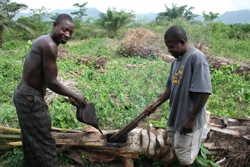 Wayne's Ghana Guide (Bill's Little Brother) provides an excellent account of akpeteshie:
Wayne's Ghana Guide (Bill's Little Brother) provides an excellent account of akpeteshie:
"Akpeteshie is the national liquor of Ghana. It is made by distilling naturally-fermented palm wine, a sweet drink made from the sap of various species of palm tree. Akpeteshie is a clear white gin produced locally under palm-thatched huts in the bush.
The process of making Akpeteshie starts with felling palm trees, which grow singly or in groves planted for this purpose. This involves undercutting the palm to sever the roots so that the palm falls over. It is very hard work, performed with a flat blade of iron at the end of a pole. Once down, the lower fronds of the palm are cut away, and the trunk is tapped by cutting a rectangular chamber on one side. Three sides of this chamber are burned to slow rotting, and a small hole is drilled into the bottom. Palm sap flows from the top of the trunk into the chamber and drains through this hole into a jug placed under the trunk. The sap collected from several palms is poured into plastic barrels to ferment naturally in the heat. Ghanaians used to use metal barrels salvaged from anywhere for this, but concerns about metals and other pollutants convinced them to used plastic barrels. The palm wine that is produced in this way is milky white in color, and very sweet. It bubbles away under plastic sheet covers in the tropical sun.
Once fermented, the palm wine is poured to metal barrels to be distilled. According to Ntow, distillation is always done under a thatched roof. We visited one distillery in the bush near Brekumansu. The barrels are fired with wood from below, and the alcohol vapors are transferred through copper tubing to another barrel filled with water. The water cools the vapors which condense back into a liquid, which is collected through a cloth-filled funnel into containers beneath the condensing barrel.

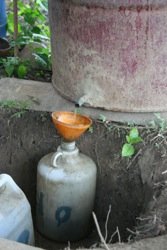 The first distillate collected from a new batch of palm wine is very high in alcohol, being nearly 95% ethanol. Ntow says that this early Akpeteshie can be used to sterilize hospital equipment and even as petrol to run cars. This is similar in concept to corn ethanol being used in Brazil, and now America, to add to petrol for cars. It also can be diluted to 40-60% alcohol, the normal strength of Akpeteshie for drinking. As the distillation continues, the alcohol content decreases to 20-30%, at which time the distillation process is stopped.
The first distillate collected from a new batch of palm wine is very high in alcohol, being nearly 95% ethanol. Ntow says that this early Akpeteshie can be used to sterilize hospital equipment and even as petrol to run cars. This is similar in concept to corn ethanol being used in Brazil, and now America, to add to petrol for cars. It also can be diluted to 40-60% alcohol, the normal strength of Akpeteshie for drinking. As the distillation continues, the alcohol content decreases to 20-30%, at which time the distillation process is stopped.
Akpeteshie is sold and consumed locally, or can be sold to distributors. Many different brands of Akpeteshie were being made in Ghana some years ago, until laws were passed to preserve the heritage of the national liquor of Ghana. It is typically drunk straight and at ambient temperature. It has a pleasant taste, with hints of its palm wine origins. Too much of it, however, is too much."
animals
Tracking down mammals in the wild was a major preoccupation this trip. Wayne helped me out hugely by keeping just as meticulous an animals list as he did for birds, and being Wayne he added everything else from the animal kingdom that we caught a glimpse of, dead or alive. Where we made a photographic record, I've illustrated his original charts. On the grounds that most of the readers of this version (including myself) will be more confused than informed by the detail, I took the liberty of removing several of the taxonomic ranks from his original file. Apologies if this offends, copies of the original available on request.
banku
Fermented corn/cassava dough mixed proportionally and cooked in hot water into a smooth whitish consistent paste. Served with soup, stew or a pepper sauce with fish. Wayne's favorite is banku served with Akwaaba sauce.
beer
Beer is popular in Ghana, and is sold in 12 and 22 oz bottles. A large bottle typically costs between 1.5 Ghc-2.5 Ghc. Star (pronounced "Staah"), Club, Gulder, Stone and Gold Arrow are popular lager beers, although both Alexis and Wayne prefer Castle Milk Stout, a darker and heavier beer. (Be aware that the bottles that minerals or beer is served to you in are owned by the bottling company—if you do not return it to the seller, they stand to lose 5,000—more than you most likely paid for the drink. If you are not going to consume the drink at the spot or at the roadside stand, make sure you let the seller know. Often, you will be asked for a deposit which will be returned upon the return of the bottle.)
blog
Not just any blog but in this case specifically the myspace entry for Dorea Wilder: http://blog.myspace.com/index.cfm?fuseaction=blog.ListAll&friendID=47038442 which now seems to need a personal invite to access. Which you don't have.
Boabeng-Fiema Monkey Sanctuary
Boabeng-Fiema Monkey Sanctuary is unique. It is the only place where two different species of monkeys, regarded as sacred - the Campbell's Mona and the Geoffroy's Columbus - live together within the same habitat in peace and in harmony with human beings. Monkeys around the world do not enjoy this status, according to Wildlife Experts. Mr Jake Obetsebi-Lamptey, Minister of Tourism and Modernisation of the Capital City, observed during a trip to the Sanctuary that Boabeng-Fiema could be an icon for the implementation of a national Tourism Action Plan that seeks to increase tourists arrivals to more than a million. [RT: Currently they have a staff of 4 guides.]
Mr Obetsebi-Lamptey paid a visit to the Sanctuary as part of activities marking this year's World Tourism Day. Boabeng and Fiema villages in the Brong Ahafo Region have become synonymous with monkeys. There are about 500 Mona monkeys in the Sanctuary. They are brownish and omnivorous. The black and white Geoffroy's Columbus monkeys number about 200. They are vegetarians, living on leaves mainly. Boabeng-Fiema Monkey Sanctuary typifies traditional African conservation - the Ghanaian way. Here the culture of the people has been fashioned to include the acceptance of the monkeys as part of the society. The two communities came together in 1975 to pass a byelaw, prohibiting harm to the monkeys. They revere the animals with the belief that the monkeys are the children of the God of the twin-community. A visitor to the Sanctuary in the early morning would certainly hear monkeys calling loudly to one another.
A local folklore has it that a hunter, who once lived in Boabeng, came into contact with a spirit being called Daworo sometime around 1842. In the course of the relationship he went to the forest one day and saw five monkeys gathered around a pot covered with calico. The hunter was mesmerised and could not shoot them. When he consulted Daworo it told him to treat the monkeys as relatives. Dawuro asked the hunter to take the calico home and when he did that the monkeys followed him home. With time the number of the monkeys increased and the fortunes of the hunter also increased. The hunter attributed his improved material condition to his association with the monkeys and this led to a symbiotic relationship that has persisted to this day. Any monkey that died was buried and funeral rites held for it just as human beings.
At Boabeng-Fiema one thing that catches the eye is the cemetery where monkeys, priests and priestesses have been buried together. There are graves that have inscriptions like "Adult Male Mona Monkey, Buried on 5th December 1987" and "Baby Male Mona, Juvenile Male Mona, Buried on 7th March 1993". There are graves, which also have names of priests and priestess, like Afia Boahen in the cemetery. The monkeys are buried in a coffin or an empty key soap carton they are always covered with white calico before burial. The cemetery has 12 graves at present. Whenever a monkey is about to die, it comes to the village to die. They live for between 30 to 50 years. There is a law by the Ghana Wild Life Society that states that whoever kills any of the monkeys would be prosecuted and jailed if found guilty.
However, according to the laws of the area, who ever kills a monkey suffers a calamity. The story is told of a man, who killed a monkey in the 18th century and all his relatives died one after the other soon after. The rule also requires that anyone who kills a monkey accidentally should report. People of Boabeng-Fiema observe Fridays as special days for the monkey and do not go to the farm. In the two villages monkeys are seen playing with children. They jump from roof to roof without any apprehension. Boabeng-Fiema is a place where every Ghanaian and every tourist ought to visit. It is a place where monkeys live happily together with human beings. The Baboons in South Africa are not so lucky as they are gunned for stealing common chocolate.
3. At Nkoranza hire a taxi ($10) or take a tro-tro to boabeng and Fiema where you can spend some good time with us!!
baobab
The baobabs, totaling about a dozen species, are native to the hot dry savannas in Africa, Madagascar and northern Australia. The baobab tree, the "tree of life," is also known as the monkey bread tree, cream of tartar tree, lemonade tree and sour gourd tree. The baobab tree has an enormous trunk with tapering branches and can attain a maximum height of 75 feet and maximum diameter of 60 feet around the trunk thus creating a bottle-like appearance. The baobab is leafless for nine months of the year. In the wet months, water is stored in its thick, corky, fire-resistant trunk for the nine dry months ahead. Some baobabs are reputed to be many thousands of years old, which is difficult to verify as the wood does not produce annual growth rings.
The baobab looks like "the devil plucked up the baobab, thrust its branches into the earth and left its roots in the air." One legend describes what happens if you are never satisfied with what you already have: "The baobab was among the first trees to appear on the land. Next came the slender, graceful palm tree. When the baobab saw the palm tree, it cried out that it wanted to be taller. Then the beautiful flame tree appeared with its red flower and the baobab was envious for flower blossoms. When the baobab saw the magnificent fig tree, it prayed for fruit as well. The gods became angry with the tree, and pulled it up by its roots, then replanted it upside down to keep it quiet."
The baobab is highly regarded by African people because all of its parts can be utilized in some capacity. In addition to being an important source of timber, the trunks are often hollowed out by people who use them for shelter, grain storage or as water reservoirs. The hollowed trunks also serve as burial sites. Some of the most important products come from the bark of the tree, which contains a fiber that is used to make fishnets, cords, sacks and clothing. The bark can also be ground into a powder for flavoring food. The leaves of the baobab were traditionally used for leaven but are also used as a vegetable. Its fruits and seeds are also edible for humans and animals. The pulp of the fruit, when dried and mixed with water, makes a beverage that tastes similar to lemonade. The seeds, which taste like cream of tartar and are a valuable source of vitamin C, were traditionally pounded into meal when other food was scarce. Other products such as soap, necklaces, glue, rubber, medicine and cloth can be produced from the various parts of the baobab tree.
birds
As usual on our joint expeditions (and everywhere else he goes) Wayne kept meticulous notes on the birds he saw, and in the event that they were slow, large, close, colorful, plentiful or noisy enough the ones that I saw too. See also his animals list.
Bradt
Ghana Philip Briggs, published by Bradt Travel Guides Ltd, UK. We were traveling with the Fourth Edition, August 2007. There is remarkably little cohesive Ghana information on the interweb, and even less in print. It was a pleasant surprise then, to find this guide both personably written, and reasonably accurate. Given how few choices there were it should not have been such a surprise to find all the obruni carrying it, which in turn meant that the locals all knew it too, and so on more than one occasion we were asked to write to the publisher to correct some grievance or other. The result was that the book seemed more than a book, it had a life and personality of its own.
bucket bathroom
At first glance a bucket bathroom looks just like a regular bathroom. The big difference is that despite the tempting looking faucets, in fact there is no, or exceeding little, actual running water. Instead somewhere nearby is some sort of reservoir, and some other sort of device (typically a small collection of buckets) you can use to portion out the water. You can then use this to fill the cistern, or with sufficient skill you can force the siphon effect yourself by direct pouring. Likewise you can stand/squat in the bath, and pour the bucket over yourself, or scoop it out a handful at a time for a more leisurely soak. Where the facilities are laughingly described as having running water, they nevertheless tend to have all the buckets nearby, so that if you are lucky enough to find a reasonable flow you know you need to fill them while the going is good—next time you will not be so lucky.
calabash
Hollowed out and dried calabashes are a very typical utensil in households across West Africa. They are used to clean rice, carry water and also just as a food container. Smaller sizes are used as bowls to drink palm-wine (and pito). Calabashes are used by some musicians in making the kora (a harp-lute), xalam (a lute), ngoni (a lute) and the goje (a traditional fiddle).
cashew nuts
Cashew orchards were everywhere. We had several close encounters. First we stopped at a random grove and took pictures of the fruit. At the monastery we saw the nuts laid out to dry in the sun having been stripped from the main body of the fruit, then being collected up into 200kg? sacks (three feet tall, 18 inches in diameter).
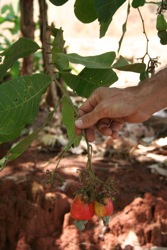
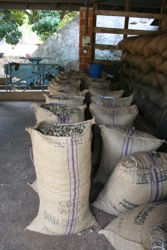 In Bole, at the Cocoa Research Institute of Ghana we saw where they were then steamed, hulled, sorted, graded, and roasted. Two women sat at what looked like treadle sewing machine tables, but which turned out to be nut crackers with foot-operated jaws. Every nut was cracked individually by hand, and trying to be careful, because as we all know, whole nuts are more valuable than broken ones. At this time of year (March, end of the dry season) apparently there is a high breakage rate. The director pointed out that oil in the shell is poisonous (the chemical turns out to be related to poison ivy) so the women are constantly dipping their fingers into a bowl of (presumably more benign) oil to protect their skin. The next set of women cleaned up and skinned the nuts and nut pieces. Now we regretted our promise, because there were great pictures to be had of the workers picking away behind their endless mountains of nuts. The women apparently like the work because it is government run, and therefore pays well, and it is only a forty-hour week. Not a scrap is wasted. Not only are the broken pieces put through their own sorting process, but one woman's job is to take nuts with slight discoloration, carve out the blemish and put the nut back into circulation. This is not all for the look. It turns out that the blemishes can make the nut taste bitter.
In Bole, at the Cocoa Research Institute of Ghana we saw where they were then steamed, hulled, sorted, graded, and roasted. Two women sat at what looked like treadle sewing machine tables, but which turned out to be nut crackers with foot-operated jaws. Every nut was cracked individually by hand, and trying to be careful, because as we all know, whole nuts are more valuable than broken ones. At this time of year (March, end of the dry season) apparently there is a high breakage rate. The director pointed out that oil in the shell is poisonous (the chemical turns out to be related to poison ivy) so the women are constantly dipping their fingers into a bowl of (presumably more benign) oil to protect their skin. The next set of women cleaned up and skinned the nuts and nut pieces. Now we regretted our promise, because there were great pictures to be had of the workers picking away behind their endless mountains of nuts. The women apparently like the work because it is government run, and therefore pays well, and it is only a forty-hour week. Not a scrap is wasted. Not only are the broken pieces put through their own sorting process, but one woman's job is to take nuts with slight discoloration, carve out the blemish and put the nut back into circulation. This is not all for the look. It turns out that the blemishes can make the nut taste bitter.
cassava
From wikipedia:
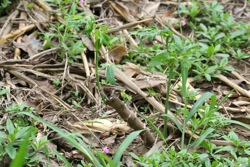
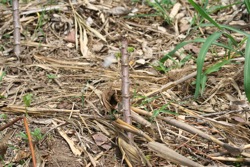 The cassava (Manihot esculenta) is a woody shrub of the Euphorbiaceae (spurge family) native to South America that is extensively cultivated as an annual crop in tropical and subtropical regions for its edible starchy tuberous root, a major source of carbohydrates. Indeed, cassava is the third largest source of carbohydrates for human food in the world, with Africa its largest center of production.
The cassava (Manihot esculenta) is a woody shrub of the Euphorbiaceae (spurge family) native to South America that is extensively cultivated as an annual crop in tropical and subtropical regions for its edible starchy tuberous root, a major source of carbohydrates. Indeed, cassava is the third largest source of carbohydrates for human food in the world, with Africa its largest center of production.
The leaves cannot be consumed raw since they contain free and bound cyanogenic glucosides. These are converted to cyanide in the presence of linamarase, a naturally occurring enzyme in cassava. The roots, however, are eaten raw everywhere in Africa. Cassava varieties are often categorized as either "sweet" or "bitter", signifying the absence or presence of toxic levels of cyanogenic glucosides. The so-called "sweet" (actually "not bitter") cultivars can produce as little as 20 milligrams of cyanide per kilogram of fresh roots, while "bitter" ones may produce more than 50 times as much (1 g/kg). Cassavas grown during drought are especially high in these toxins. One dose of pure cassava cyanogenic glucoside (40mg) is sufficient to kill a cow.
check in
People did not believe my claims for the number of check points at the airport, so here they are:
Curbside
- Entry door: uniformed officer asks if we're flying. Alexis says "I'm with them" and pushes through with us.
- Customs. We were shown to the front of the line and a customs officer made a cursory search of one of our backs, and initialed all of them in chalk
- To join check-in line we have to show the chalk marks, I'm pushing the trolley, and start to put the bags on the scales, but when they see that the bags belong to two people not one, the weighing stops and we join the line.
- Passport control labeled each bag, scanned our passports on a laptop with a portable scanner.
- Check in. Confirmed the tickets. Added the airline barcode/destination labels, handed the bags back.
- Bag check. Now the bags were searched much more thoroughly, but respectfully, and they tried hard to help put them back together again. A friendly discussion about what we were carrying (our akpeteshie bottles, and my wood carvings). The officer was thrilled and impressed that we a) drank akpeteshie b) were exporting it. He lovingly repacked it. Finally they took the bags, leaving us with hand luggage.
- Immigration control. By now we feel like were in the home straight, and we're also beside the last eating opportunity. So while we fill in the forms, we order coffee and our last plate of fried yams. They call final boarding while were sitting there, which is a little weird, since there's still 90 minutes to go. It turns out this is when they shut the check-in counter. Not here 90 minutes before, you are not getting on the plane I guess. We wave the forms at the immigration check and join the line for...
- ...immigration control. I pissed this guy off. "where is this?" "About forty miles outside Accra." "I asked you where you stayed last night. You did not stay in forty miles outside Accra last night." "Okay that is true, we stayed in a hotel in Accra. Swiss-something or other." "Swiss what?" "I don't remember." "You need to remember." I called across to Wayne, but he couldn't remember either. I said "It is the place the Peace Corp Volunteers stay". He looks around, shakes his head, stamps my passport, and tosses it back to me. Phew.
- Half way down the corridor to the gate the same guy who'd been directing traffic in the check-in crowd stops everyone to make sure they each have a ticket and a boarding pass.
- Now we can see the gate. Two more checks here: a thorough search of out hand luggage, during which Wayne was asked for a bribe, and...
- ...a body search. Fortunately without the aid of latex gloves and flashlights.
- Finally, at the foot of the gangway up to the aircraft, a last boarding card check.
cocoa
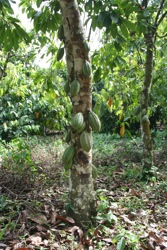 Ghana's most famous food is cocoa—Ghana is the world's third largest producer of cocoa. It is one of the country's major exports and is used to make chocolate. Cocoa production occurs in the forested areas of the country-- Ashanti Region, Brong-Ahafo Region, Central Region, Eastern Region, Western Region, and Volta Region--where rainfall is 1,000-1,500 millimeters per year. The crop year begins in October, when purchases of the main crop begin, while the smaller mid-crop cycle starts in July. All cocoa, except that which is smuggled out of the country, is sold at fixed prices to the Cocoa Marketing Board. Although most cocoa production is carried out by peasant farmers on plots of less than 3 hectares, a small number of farmers appear to dominate the trade. Indeed, some studies show that about one-fourth of all cocoa farmers receive just over half of total cocoa income.
Ghana's most famous food is cocoa—Ghana is the world's third largest producer of cocoa. It is one of the country's major exports and is used to make chocolate. Cocoa production occurs in the forested areas of the country-- Ashanti Region, Brong-Ahafo Region, Central Region, Eastern Region, Western Region, and Volta Region--where rainfall is 1,000-1,500 millimeters per year. The crop year begins in October, when purchases of the main crop begin, while the smaller mid-crop cycle starts in July. All cocoa, except that which is smuggled out of the country, is sold at fixed prices to the Cocoa Marketing Board. Although most cocoa production is carried out by peasant farmers on plots of less than 3 hectares, a small number of farmers appear to dominate the trade. Indeed, some studies show that about one-fourth of all cocoa farmers receive just over half of total cocoa income.
Although Ghana was the world's largest cocoa producer in the early 1960s, by the early 1980s Ghanaian production had dwindled almost to the point of insignificance. In 1983 farmers were provided with seedlings to replace trees lost in the drought and trees more than thirty years old (about one-fourth of the total number of trees in 1984). In addition, a major program to upgrade existing roads and to construct 3,000 kilometers of new feeder roads was launched to ease the transportation and sale of cocoa from some of the more neglected but very fertile growing areas on the border with Côte d'Ivoire. Furthermore, the government tried to increase Ghana's productivity from 300 kilograms per hectare to compete with Southeast Asian productivity of almost 1,000 kilograms per hectare. New emphasis was placed on extension services, drought and disease research, and the use of fertilizers and insecticides. The results of these measures were to be seem in rising cocoa production in the early 1990s.
Interesting aside: Notice that the flower and the fruit grow directly from the main trunk. Most woody flowering plants produce inflorescences on new growth and or young leafy shoots. A few, however, including cacao (Theobroma cacao), flower and fruit directly on their trunks or main branches. This unusual botanical trait is called cauliflory and the plants themselves are considered cauliflorous. The term is derived from the Latin caulis, meaning stem, and flor, meaning flower. (Although the vegetable cauliflower (Brassica oleracea) has the same name, it is not cauliflorous – the dense cluster of unopened flower buds that we eat arises from a main flower stalk.)
currency
The Ghanaian Cedi was revalued between Wayne's first trip in 2007 and ours in March 2008. 10,000 old Cedi became 1 Ghc and conveniently if not without coincidence this fairly accurately equated to one dollar. As always, although this made things a lot easier to calculate and keep track of, prices seemed to make a huge jump during this process, which often caught Wayne off guard. Incredibly, the old Cedi was still subdivided into peswas, and folks often used these when discussing prices. Between their confusion, "inflation" and our lack of understanding for what a thing should cost, there was a huge margin for error, and it was often necessary to check and triple check that there was a mutual understanding of the actual figure.
dash
Pronunciation: (dash), (in West Africa)
—n.
1. a tip, bribe, or recompense.
2. bribery.
—v.t.
to give a tip or bribe to (esp. a government employee).
elephants
See African elephants.
food
In general and in principle we ate local, except Alexis, who ate American whenever she could. This was understandable, since she was the local. We did this in part because of course we would—experimenting with the cuisine is an essential part of any such trip—and in part because there were going to be times when we had no choice. In Brekumansu where we were hosted by local family, not only was local going to be the only choice, but there would only be one thing on offer, so we'd better be able to eat it. Furthermore, we would eat local-style, using only your right hand. So practice was a good thing.
The food was excellent, though very different from what we are used to. By sticking strictly to our rules of only eating hot, freshly cooked meals, and bottled water or alcohol, we managed at avoid any sort of stomach issues.
Individual dishes that we particularly enjoyed are listed in their own right. We also occasionally ate fresh fruits such as pineapple, mango, avocados (known locally as pears), papaya, coconut, oranges, and bananas which were in season. We (Wayne) went scrumping for most of what we enjoyed.
fufu
Cassava and plantain pounded together until they make an elastic dough not dissimilar to bread. But then it is boiled, and served, classically, with groundnut soup.
Cornie wrote after her trip: "In Brekumanso, fufu is made several times a week by boiling cassava and plantain and pounding the pureed mixture until it takes on a firm consistency. It is shaped into a ball and served with a variety of soups. We had palmnut soup with fufu at Ntow's. Fufu is a ubiquitous and much-loved staple throughout most of West Africa. It can be topped with a fiery sauce or served as the bland accompaniment to a main dish. If an Akan man has eaten a meal, but it is without fufu, he will claim he has not eaten."
An absolute staple then, and one of Alexis' favorite foods.
Geoffroy's black and white colobus monkey
The name "colobus" is derived from the Greek word meaning "docked" or "mutilated." Colobus monkeys once were thought to be abnormal because they have no thumb, or only a small stub where the thumb would usually be. This is actually an adaptation rather than a mutilation which allows colobus monkeys to easily travel along the tops of branches quadripedally.
Black-and-white colobus have a long, black fur coat with a white stripe running down the sides of their backs to their tails. Their bushy tails, which often exceeds the length of their bodies, are black at the base and gradually becomes white. They range across west Africa from the Ivory coast to Nigeria. They live in multi-male, multi-female groups, with an average of 16 members. Females in the group remain for life, males leave as they near sexual maturity. They are diurnal and arboreal, although they travel across the ground between forest patches in savannah habitats.
Ghc
Ghanaian Cedi. The local currency. See currency.
grasscutter
Grasscutter certainly sounds better than its other name, the Greater Cane Rat, especially since they are about two feet long and weigh in at 15lbs or so. Cane rats live in small groups led by a single male. They are nocturnal and make nests from grasses or burrow underground. They live by reed beds and riverbanks, which precisely describes the location of the hippo hide we camped on.
One of the most common forms of bush meat we half expected to find grasscutter on the menu at some point. We certainly saw the meat for sale, and the ecotourist site near Brekumansu was rearing them for consumption.
http://news.bbc.co.uk/2/hi/business/4864714.stm
ground-nut
We had many discussions about ground nuts, one of our favorite flavors. Some contend that it is just another word for peanut, but I thought I could taste the difference--ground nuts were not as sweet as peanuts. Webster offers this:
Main Entry:
ground·nut
Pronunciation:
\'grau'n(d)-.nut\
Function:
noun
Date:
1602
1 a: any of several plants having edible tuberous roots; especially : a North American leguminous vine (Apios americana) with pinnate leaves and clusters of brownish-purple fragrant flowers b: the root of a groundnut
2 chiefly British : peanut
So it seems, given Ghana’s close ties to UK, that ground nut could indeed be peanut, especially as it is unlikely to be the north American vine described in the first entry.
ground-nut paste and stew
Groundnut paste is liquefied and cooked together with well-seasoned fish, meat or chicken. We often saw this delicious, peanut-butter-like concoction being boiled in huge cauldrons in the market. A popular way to buy it was in small plastic sachets containing just a couple of tablespoons—one serving, so the ten gallons or so in the cauldron represented literally thousands of sales.
honey
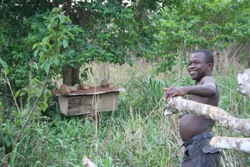
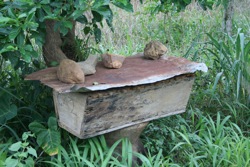 According to an article on the Bees for Development web site:
According to an article on the Bees for Development web site:
[In 2005] Ghana had about 5000 beekeepers with an average of five hives per person. Working on an average yield of 14kg honey per beehive per year, beekeepers provide about 70 metric tonnes of honey on to the Ghanaian market. The quality of the honey on the Ghanaian market has a direct relationship with source of production (from wild hunters or beekeepers) and the method of extraction.
Wild honey always is exposed to lots of smoke during harvest and again at processing time. Another source of contamination of the honey may come from remnants of brood and other contents of the nest since the hunters remove everything in the bee nest. The honeycombs from the plundered bee nest may be processed in two main methods. The first is where the hunters squeeze the combs to drain the honey right there in the bush and in the middle of the night. The second processing method is even the worse of the two. It involves placing the combs in a metallic bowl that has perforations at the base. Ambers of fire are put on the combs to burn .The honey and beeswax are melted by the heat of the fire and are collected in another receptacle that is placed below the first. The honey so extracted is always black, sooty and of very low quality.
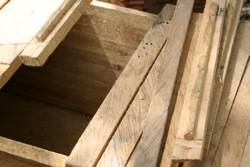
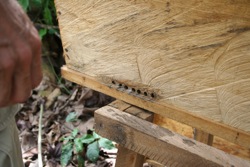 Honey from beekeepers may be good in quality if honeycombs are handled and processed properly. Very few beekeepers use heat to extract honey from combs. They ignorantly use the solar wax extractor to obtain the honey.
Honey from beekeepers may be good in quality if honeycombs are handled and processed properly. Very few beekeepers use heat to extract honey from combs. They ignorantly use the solar wax extractor to obtain the honey.
The heat build-up in this equipment in the tropical sun is so high that it overheats the honey. Cold extraction methods of draining chopped honeycombs overnight and the use of a honey press produce the best quality honey.
Ntow then, is a beekeeper not a bee hunter, or at least he would be if he had attracted any bees to his hive. As with everything else, he was very proud of his hives.His hive is clearly of the "top bar" type, an improvement introduced back in the 70's. The web site also claims that he might expect to collect about 14kgs of honey from a hive, and that local honey was selling for around 6 Ghc per kilo. The pictures show that he had at least two hives (one is visibly newer than the other) which might well explain why it was still empty, but I seem to remember that the more established one was also empty.
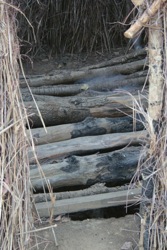 long drop
long drop
Aptly descriptive local term for an outhouse or earth latrine. We saw many from the outside, but only closely examined one example, at Wechiau. Unlike western long drops, this one was a huge pit covered with branches which you prayed would support your weight while you presumably tried to maneuver your deposits through the gaps.
Discretion and valor bedamned, we took photos but then took our chances with the snakes out in the bush rather than test the timber.
leishmaniasis
According to the CDC, "leishmaniasis (LEASH-ma-NIGH-a-sis) is a parasitic disease that is found in parts of the tropics, subtropics, and southern Europe. People who have cutaneous leishmaniasis have one or more sores on their skin. The sores can change in size and appearance over time. They may end up looking somewhat like a volcano, with a raised edge and central crater (ulcer). Some sores are covered by a scab. The sores can be painless or painful." No wonder then, that some pretty high-ranking quacks thought I might have it.
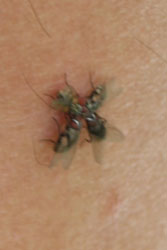 I got bitten badly by the tsetse flies in Mole. By the time we reached Brekumansu most of these bites had healed up, but the ones that hadn't, itched. As a result of my scratching, some of them might have oozed a little. The oozing seemed particularly interesting to the local flies. We came home, and two of the sores in particular started to get worse. Much worse. The final two straws were a) although they started out harmlessly enough, now they were causing me quite severe pain, sometimes debilitatingly so b) far from them improving, a third one started to develop—so we could no longer blame the Brekumansu flies. I made an emergency visit to our health clinic, and the nurse who took the dressing off the first one said "wow. Let me get the doctor" and scurried out of the room. The doc came in, took the other two dressings off and said "wow. That's the most interesting thing I seen all day." In turn, the second I mentioned Africa he immediately escalated. Within 15 minutes we were talking to a big shot at Boston's Brigham and Women's infectious diseases department.
I got bitten badly by the tsetse flies in Mole. By the time we reached Brekumansu most of these bites had healed up, but the ones that hadn't, itched. As a result of my scratching, some of them might have oozed a little. The oozing seemed particularly interesting to the local flies. We came home, and two of the sores in particular started to get worse. Much worse. The final two straws were a) although they started out harmlessly enough, now they were causing me quite severe pain, sometimes debilitatingly so b) far from them improving, a third one started to develop—so we could no longer blame the Brekumansu flies. I made an emergency visit to our health clinic, and the nurse who took the dressing off the first one said "wow. Let me get the doctor" and scurried out of the room. The doc came in, took the other two dressings off and said "wow. That's the most interesting thing I seen all day." In turn, the second I mentioned Africa he immediately escalated. Within 15 minutes we were talking to a big shot at Boston's Brigham and Women's infectious diseases department.
My worst nightmare come true, his instructions were to go home, slather the sores in vaseline, wait an hour or so, and be sure to capture and save anything that crawled out. We did that, but as I explained when he called the next day (Sunday afternoon I should add) the sores seemed to me to be far too weepy to be the result of burrowing activity. He agreed. He was not sure what to do next, but suggested if I was more comfortable, I could come in and see him the following morning. I glanced at Claudia then told him "I think my wife would prefer it if I took you up on that offer."
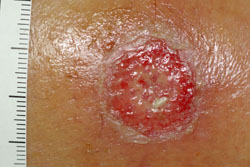 He came in early for his clinic and saw me right away. He peeled the dressing off and said "wow. No wonder your wife wanted me to see you." He taped measuring labels (metric I noticed) close to the sores, had his buddy with the fancy camera take some photographs (which he was kind enough to share with me) and escalated to dermatology department. He was embarassed to discover that his department did not have dressigs large enough to recover the sores, and had to ask me to supply my own.
He came in early for his clinic and saw me right away. He peeled the dressing off and said "wow. No wonder your wife wanted me to see you." He taped measuring labels (metric I noticed) close to the sores, had his buddy with the fancy camera take some photographs (which he was kind enough to share with me) and escalated to dermatology department. He was embarassed to discover that his department did not have dressigs large enough to recover the sores, and had to ask me to supply my own.
The next day I saw the head of dermatology. He brought in several residents. I thought I was in an episode of "House." They talked of the the Center of Disease control in Virginia. They talked to the CDC in Virginia. They were on to something, but what they were on to was notoriously difficult to diagnose, not least because culture samples would not survive the normal mediums/processes. So samples from me would need to be analysed immediately, and comparison samples (which would need to come up from the CDC) would need to be expedited. All of which was a hassle, and expensive. House turns to one of the residents, who it turns out has studied the disease in South America and Australia: "I may be the boss, but you are the expert in the room. Does this, or does it not, look like leishmaniasis? Yes, or no?" The young man is still careful with his words. "I have seen sores that look like these, that have indeed turned out to be leishmaniasis, yes."
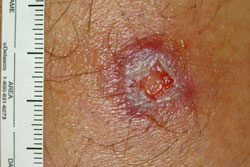 It was agreed that although it was a little premature, it would be painful, and it would probably leave a scar, they would perform a biopsy on the worst of the sores. I told them my modeling days were over, and that if it only saved me making yet another trip into Boston I was game. They took their pound of flesh, and I went home.
It was agreed that although it was a little premature, it would be painful, and it would probably leave a scar, they would perform a biopsy on the worst of the sores. I told them my modeling days were over, and that if it only saved me making yet another trip into Boston I was game. They took their pound of flesh, and I went home.
I got steadily worse all week. By Thursday night I was running a fever, I couldn't straighten the leg out, and I even had a killer sore throat. I had a critical deadline with a customer on Friday, but the boss told me to go home and not to come back until I was fixed. Afterwards I learned that there were some in the office who were seriously starting to wonder if I was going to survive. So instead of going to work, I went back to Boston. To be more accurate, Claudia took me to Boston. She no longer trusted me to drive. The doc said that the biopsy had not reveiled anything positive (a risk we knew) and that the only thing they had any confirmation of was the streptococcus grown by the original triage doc in the emergency clinic. He switched me on to meds to attack that.
We went home and I slept until Sunday. Friday night and Saturday night I had the sweats so badly I thought I'd wet the bed. Early Sunday morning I ran out of household pain meds, and took one of the percocet the doc had prescribed. An hour later, Claudia came in, just as I was ready to throw up. This was her darkest moment, because things seemd to still be getting worse. But as soon as I'd used the bucket, I felt way better. By lunch time all my symptoms had disappeared. I had a fabulous few days "sick" waiting for the doc's clear bill of Health on Thursday. Feeling better than I'd done in weeks, I read, watched movies, did a little gardening in the warmth of a suddenly exploded spring. That was that. As predicted, I have three interesting marks on my leg, and the one where the biopsy went in probably qualifies as a scar, and that's it. All's well that ends.
maize
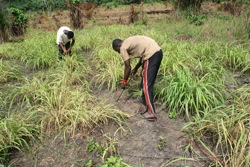
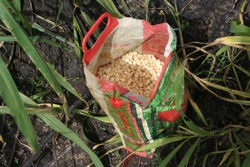 Maize (Zea mays L.) plays a very important role in human and animal nutrition in Ghana. It is a major source of protein and energy in adult and infant nutrition. However, the normal maize protein is deficient in two essential amino acids, lysine and tryptophan. In Ghana, a thin gruel made from maize is the first major supplementary food fed to weanling children. This gruel is deficient in both protein and calories. However the poor economic status of the average Ghanaian family does not permit the addition of more costly protein sources such as milk, meat and beans.
Maize (Zea mays L.) plays a very important role in human and animal nutrition in Ghana. It is a major source of protein and energy in adult and infant nutrition. However, the normal maize protein is deficient in two essential amino acids, lysine and tryptophan. In Ghana, a thin gruel made from maize is the first major supplementary food fed to weanling children. This gruel is deficient in both protein and calories. However the poor economic status of the average Ghanaian family does not permit the addition of more costly protein sources such as milk, meat and beans.
Ntow took us out to farm and showed us workers planting maize, pacing along a string line and then using their machetes to dig a small hole into which they dropped a kernel or two and an animal deterrent. They scratched over the hole again with the tip of the blade, took another stride and then repeated the process.
Mole National Park
World 66 Mole National Park Travel Guide
Mole National Park is home to 93 mammalian species, 33 reptiles nine amphibians and an estimated 300 birds species. The mammals include some 600 elephants, 2,000 roan antelopes, 3,000 hartebeests, 4,000 waterbucks, 5,000 buffalo and some 6,000 warthogs. Uncounted lions, leopards, hyenas and various primates [two, count 'em] can also be seen in Mole. [RT: Lions, leopards, and hyenas? Ha ha ha. Last I heard, lions for one have not been seen in what was it, 30 years?]
But Mole National Park has got much much more to offer. A wide range of accommodation is available at the motel from tents to low-budget hostel style accommodation to en-suite chalets with fan overlooking the watering hole. The prices are higher than in other parts of the north, but again the motel is the only option for accommodation. Be aware that the electricity supply at the motel is only powered by generator.
Travel Africa Magazine Online :
Of all the wondrous places in Africa, few can equal the sheer simplicity of Mole, perched there, high up on a ridge overlooking the surrounding wooded savannah. It is not that there are more animals than elsewhere, nor that there is a wider variety. No, Mole Game Reserve is no more abundant, but what it does have is a certain magic, an atmosphere of bygone days untainted by tourism and the effects of commerce. This place will whisk you back 50 years in an instant.
A stunning panorama awaits you. And, in places, a wicked drop to the savannah floor. As if carved out of the hillside just for us, the ridge extends in a crescent from southeast to southwest; in all about a quarter of a mile. Just long enough for a leisurely stroll in the cool of sunrise, or at mid-afternoon as you dash from one shady tree to the next with a pair of binoculars in one hand and a cold drink in the other. One hundred feet down to a waterhole below, crocodiles cruise, antelope graze, elephant bathe and monkeys play. Then, without fail, at dusk a glorious sunset will drop into the infinity of beyond and awaken humble thoughts, as "African lights" are lit on your verandah to welcome the blackness ahead.
mona monkey
Mona is the Moorish word for "long-tailed monkey". Mona monkeys have a red-brown to brown-agouti fur coat on their dorsal surface. Their ventral surface and buttocks are white. The upper half of their face is bluish-gray with a white band on their forehead. They have dark eyebrows and a pinkish snout. Around their face, the hair is yellow and a dark stripe runs from between their eyes to the ears. Their cheeks are grayish-yellow and their lips are white. Other prominent features are their long thick sideburns and white long tufts on their ears. Their tail is near black on top while gray underneath with a black tip at the end. Mona monkeys live in groups of 8-35 (average 12), typically consisting of one male and numerous females. They are diurnal and arboreal, and move quadrupedally through the forest.
obruni
"White man" or more romantically (and accurately?) "man from the horizon." Smalls followed us everywhere, shouting "obruni, obruni!" and it was also common for shop keepers and the like to use it to get our attention. It never felt like it was being used maliciously or disrepectfully. If anything it was the converse. On a later trip to the UK, the woman at the check-in desk noticed my Ghana visa. She was from Accra and was clearly surprised to find a caucasian with Ghana in his travel history. Just like all the others we'd met, she seemed flattered, and keen to make sure that I'd enjoyed my trip. "Have a nice life, obruni" she said as she handed back my documents.
omo tuo
This is tenderly cooked rice that is molded into balls (baseball-size) and taken with palm-nut soup or groundnut paste soup.
palmnut oil
Harvesting palmnut oil was a principle occupation for Ntow and his neighbors. The shed that protected his mills, and the cauldrons of hot oil took up most of his compound.
Palmnut oil is a staple in Ghanaian foods. Palmnut clusters are harvested from the bush when they are ripe. Clusters are boiled, and then the nuts are separated from the clusters. The nuts are then pressed to release the oil, which is boiled for several hours to drive off excess water.
But they are not done yet. The residue from the press is raked through by the women and smalls to pick out the pamnut kernals. These then go through there own processing, to produce palmnut kernal oil, a much darker concoction. It was not clear to me what the locals use it for, but this is an extremely common ingredient in commerical food products of the western world, such as the first candy bar I ate on the way home.
palmnut soup (abenkwan)
Prepared from the pulp of pounded boiled palm fruits, which is cooked with onions and tomatoes, ginger, garlic, red pepe (the local super hot red chili) into a thick broth then adding fish/meat.
pepe
Considering how common pepe was, and how often it came up in conversation, I'm staggered at how difficult it is to track down any references to it on the interweb. After about an hour of searching, the most detailed and reliable source I could find was a Time Out (London) article on Ghanaian food sources in the London area: "Ghanaian food is characterised by its hearty, tasty stews and soups and fondness for chili peppers (known as pepe)." So there you have it.
pito
From Wikipedia: Pito is a type of beer common in northern Ghana, and other parts of West Africa. It is made from fermented millet or sorghum by small (household-level) producers, and is typically served in a calabash outside the producer's home where benches are sometimes provided.
It can be served warm or cold. Warm pito gets its heat from the fermentation process. Pito brewing can provide an important source of income for otherwise cash-poor households in rural areas. It is never found bottled or canned, and, as a rule, is purchased directly from the household in which it is brewed. [RT: Or in our case, off the head of the brewer.]
purwata (pure water)
"Pure" water in .5L plastic sacks. These sacks, and a black equivalent whose final content I don't even want to think about, carpet the side of the road everywhere we go, in their thousands and millions. Girls plied purwata wherever a vehicle might slow or stop. It was not clear to me how they got it cold in a country with so little power, but it was often cool enough to cause condensation to run down the head-basins, and hence the faces of the sellers. Consumers gnaw a small hole in one corner of the sack and then, since there is no way to reseal it, need to drink the contents on one sitting, or risk the sack gently draining into one's crutch or wherever else one has tried to park it, hole uppermost. To avoid this it was common practice to grip the bag with ones teeth, and just leave it dangling.
It was cheap, and Alexis bought it regularly, but Wayne and I stuck rigidly to the more reliable quality controls accorded to Voltic.
red-red
When ripe plantains are available, Sister Patience makes red-red. Cowpeas (black-eyed peas) palmnut oil, tomatoes, onion, garlic/ginger, pepe, might be named for the combination of red pepper and red palmnut oil. The red-red cowpea stew is usually served with fried plantains.
shito
Wikipedia: Shitor Din, commonly called Shito, is the word for pepper in Ghanaian native languages and is a spicy pepper sauce ubiquitous in Ghanaian cuisine. Shito sauce consists primarily of fish oil and/or vegetable oil, ginger, dried fish and/or crustaceans, tomatoes, garlic and spices. The blend of spices and fish differs between different regions and villages.
In "Salt" a book about the origins and history of salt use, there is a lengthy description of garum (and soy) two ancient concoctions with a similarly curious and complex mixture of exotic spices and fish (rotting or otherwise). In the English-speaking world, Worcester Sauce seems to fit the same bill. I have no experience with garum, but shito is much thicker than today's soy or Worcester, but they do all share a salty earthiness which sets them apart from pretty much everything else.
smalls
Young people. Say no more. Just a perfect term.
spot
Pub.
Tano Sacred Grove
Modern Ghana.com
Women are not allowed to visit the Tano Sacred Grove when they are in their menstrual period. But the irony is that the people of Tano and Bono are promised a good rainy season when virgins in their menstrual period pour water into the Odomankoma Ahina (The Pot of the Creator) and it overflows.
Odomankoma Ahina is situated at the source of River Tano and it is believed that is where the Spirit of Tano stays. Indeed, if there are no rains, virgins in their menstrual period are gathered and sent to fetch water from the Tano River into the Odomankoma Ahina. If the Pot overflows, the people of Tano and Bono are sure of a fruitful season.
The belief aside, the Tano Sacred Grove is a very beautiful sight. It is a good place for hiking, meditation and fun. It is nestled within a semi-deciduous forest, enclosed by a cluster of striking sandstone rock formations. A variety of plants, birds and butterflies are found in the Grove. The Tano River runs through big sandstones that can give shade to about 15 people at a time. There are cave bats. [We saw no "cave bats", but we did see fruit bats, which live by the millions in the trees surrounding Tano.]
According to Bono Techiman history, Tanoboase and the Sacred Grove are traditional homes of the Bono people. The Bono people emerged from a cave called Amowi hundreds of years ago. The site is, therefore, the earliest Bono settlement.
At the moment, the land is a virgin land and has not seen any farming activity at all, Mr Osei Tano, a tour guide at the place, told the Ghana News Agency. He said apart from creating walkways to enable visitors have an easy and enjoyable tour, "this place is always preserved and protected from farming".
For a visitor to be able to get to the Tano River that lies in the Grove a traditional rite has to be performed. One should not visit the Grove with a evil mind, a woman in her menstrual period should not go there and if one pretends to be a virgin and goes to fetch water from the Tano River into the Pot, she goes blind, Mr Osei Tano cautioned the GNA reporter before taking her there. The town Techiman was named after Techi, one of the four people, who evolved from a hole, according to a story told in the area.
The Tanoboase Community initiated the Tano Sacred Grove Project as an ecotourism site in 1996. It is one of the tourist attractions in Ghana that every Ghanaian would like to see, as it would excite everybody.
tro-tro
The tro-tros are minivans and micro buses. But where the American minivan might have three rows of seats, here they have been replaced by five. And the two rows beside the rear sliding door have shot-gun seats which have to be collapsed again every time someone wants to get out. But the van therefore holds about 15 people.
The tro-tro has gained a reputation of "Fast and risky", and yet is the most common form of road transportation in the country. If you are back-packing, it is almost inevitable that you would have to opt for the "tro" in order to get to your destination. Just brace yourself for the ride and you should be fine. After all everyone else takes it and some survive (Just kidding).
Voltic
One did not ask for bottled water, one asked for "Voltic." It was possible to get this in stupid little 16 or 20 ounce bottles, but you'd no sooner bought those than you'd drained them and a) had garbage to dispose of responsibly (no easy task) and b) were looking for the next source. Instead we favored the 1.5 liter bottles (50 fluid ounces), which we bought in ever larger quantities until we were up to a case at a time.


